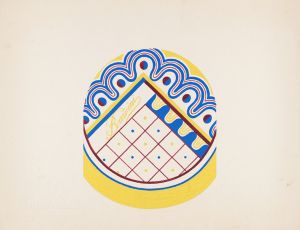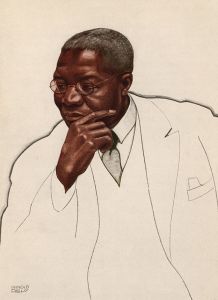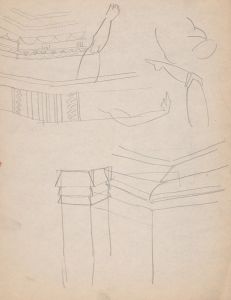
Designs for restaurant and bar interiors with curving bars and stairways.] [Sketches for bars and restaurants
A hand-painted replica of Winold Reiss’s masterpiece Designs for restaurant and bar interiors with curving bars and stairways.] [Sketches for bars and restaurants, meticulously crafted by professional artists to capture the true essence of the original. Each piece is created with museum-quality canvas and rare mineral pigments, carefully painted by experienced artists with delicate brushstrokes and rich, layered colors to perfectly recreate the texture of the original artwork. Unlike machine-printed reproductions, this hand-painted version brings the painting to life, infused with the artist’s emotions and skill in every stroke. Whether for personal collection or home decoration, it instantly elevates the artistic atmosphere of any space.
Winold Reiss was a German-American artist and designer known for his contributions to interior design and his distinctive style that combined elements of modernism with traditional motifs. Born in Germany in 1886, Reiss immigrated to the United States in 1913, where he became a prominent figure in the design of public spaces, particularly restaurants and bars. His work is characterized by the use of vibrant colors, geometric patterns, and an emphasis on creating dynamic and inviting environments.
Reiss's designs for restaurant and bar interiors often featured curving bars and stairways, which were innovative at the time and contributed to the flow and movement within the space. These elements not only served a functional purpose but also added an aesthetic quality that enhanced the overall experience for patrons. His approach to design was holistic, considering both the practical needs of the space and the emotional impact on its users.
One of Reiss's notable contributions to interior design was his work on the interiors of the New York City restaurant, Longchamps, in the 1930s. The design included bold color schemes and intricate patterns that were reflective of his unique style. Reiss's ability to blend different cultural influences into his designs made his work stand out and left a lasting impact on the field of interior design.
Reiss was also known for his sketches, which were an integral part of his design process. These sketches for bars and restaurants not only served as preliminary designs but also as works of art in their own right. They showcased his attention to detail and his ability to envision spaces that were both functional and aesthetically pleasing. His sketches often included detailed plans for furniture, lighting, and decorative elements, all of which contributed to the cohesive look and feel of the final design.
In addition to his work in interior design, Winold Reiss was a prolific portrait artist. He is well-known for his portraits of Native Americans and African Americans, which were groundbreaking at the time for their respectful and dignified representation of these communities. His portraits were often used in publications and exhibitions, further establishing his reputation as a versatile and talented artist.
Reiss's influence extended beyond his lifetime, as his innovative designs and artistic approach continue to inspire contemporary designers. His work is a testament to the power of design to transform spaces and create environments that are both functional and beautiful. Today, Reiss is remembered as a pioneer in the field of interior design, whose contributions helped shape the modern aesthetic of public spaces.
Overall, Winold Reiss's designs for restaurant and bar interiors, with their curving bars and stairways, reflect his commitment to creating spaces that are both inviting and visually striking. His sketches remain a valuable resource for understanding his design philosophy and the creative process behind his work.






![Design drawings for miscellaneous interiors, some possibly related to the Hotel St. George, New York, NY.] [Sketch for miscellaneous interior .](/imgs/249277/s/winold-reiss-design-drawings-for-miscellaneous-interiors-some-possibly-related-to-the-hotel-st-george-new-york-ny-sketch-for-miscellaneous-interior--6b46aedb.jpg)
![Design for unidentified building ‘Small Dining Room’.] [Drawing of dining room with benches, in black, vermillion and white, bilaterally positive and negative coloring](/imgs/249298/s/winold-reiss-design-for-unidentified-building-small-dining-room-drawing-of-dining-room-with-benches-in-black-vermillion-and-white-bilaterally-positive-and-negative-coloring-31217372.jpg)
![Drawings for proposed redecorations of Yorketowne Coffee Shop, Job #238, York, PA.] [Drawing #6, interior plans for tables, counters, benches](/imgs/249341/s/winold-reiss-drawings-for-proposed-redecorations-of-yorketowne-coffee-shop-job-238-york-pa-drawing-6-interior-plans-for-tables-counters-benches-c6e96b9c.jpg)
![Graphic design drawings for Barricini Candy packages.] [Study, ‘French Chocolates’ candy box, pink and black](/imgs/249347/s/winold-reiss-graphic-design-drawings-for-barricini-candy-packages-study-french-chocolates-candy-box-pink-and-black-5b35608f.jpg)
![Interior design drawings for unidentified rooms.] [Sketch for unidentified room with starred walls](/imgs/249363/s/winold-reiss-interior-design-drawings-for-unidentified-rooms-sketch-for-unidentified-room-with-starred-walls-78931be1.jpg)
![Interior design sketches for Alamac Hotel, 71st and Broadway, New York, NY.] [Incomplete interior perspective of a hallway](/imgs/249365/s/winold-reiss-interior-design-sketches-for-alamac-hotel-71st-and-broadway-new-york-ny-incomplete-interior-perspective-of-a-hallway-e54f10f2.jpg)
![Interior design sketches for Alamac Hotel, 71st and Broadway, New York, NY.] [Study for living room suite](/imgs/249366/s/winold-reiss-interior-design-sketches-for-alamac-hotel-71st-and-broadway-new-york-ny-study-for-living-room-suite-4619965b.jpg)
![Interior design sketches for Alamac Hotel, 71st and Broadway, New York, NY.] [Study of interior perspective for ‘Africa Roof’](/imgs/249367/s/winold-reiss-interior-design-sketches-for-alamac-hotel-71st-and-broadway-new-york-ny-study-of-interior-perspective-for-africa-roof-91fb1603.jpg)
![Interior perspective studies for Restaurant Crillon, 15 East 48th Street, New York, NY.] [Interior perspective study](/imgs/249374/s/winold-reiss-interior-perspective-studies-for-restaurant-crillon-15-east-48th-street-new-york-ny-interior-perspective-study-57caabec.jpg)

![Miscellaneous small sketches for inlaid table tops.] [Design with blue and orange floral motif](/imgs/249431/s/winold-reiss-miscellaneous-small-sketches-for-inlaid-table-tops-design-with-blue-and-orange-floral-motif-4e4a4b57.jpg)

